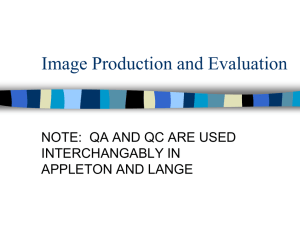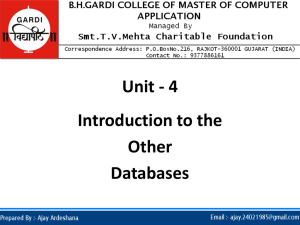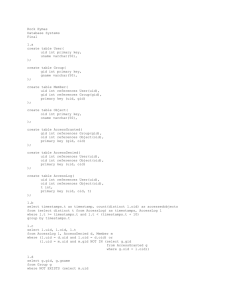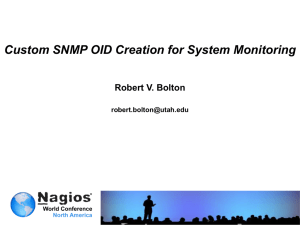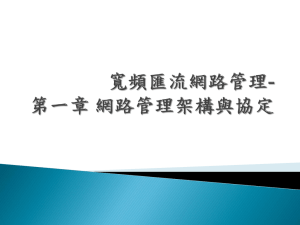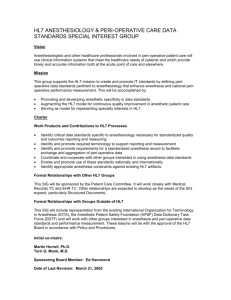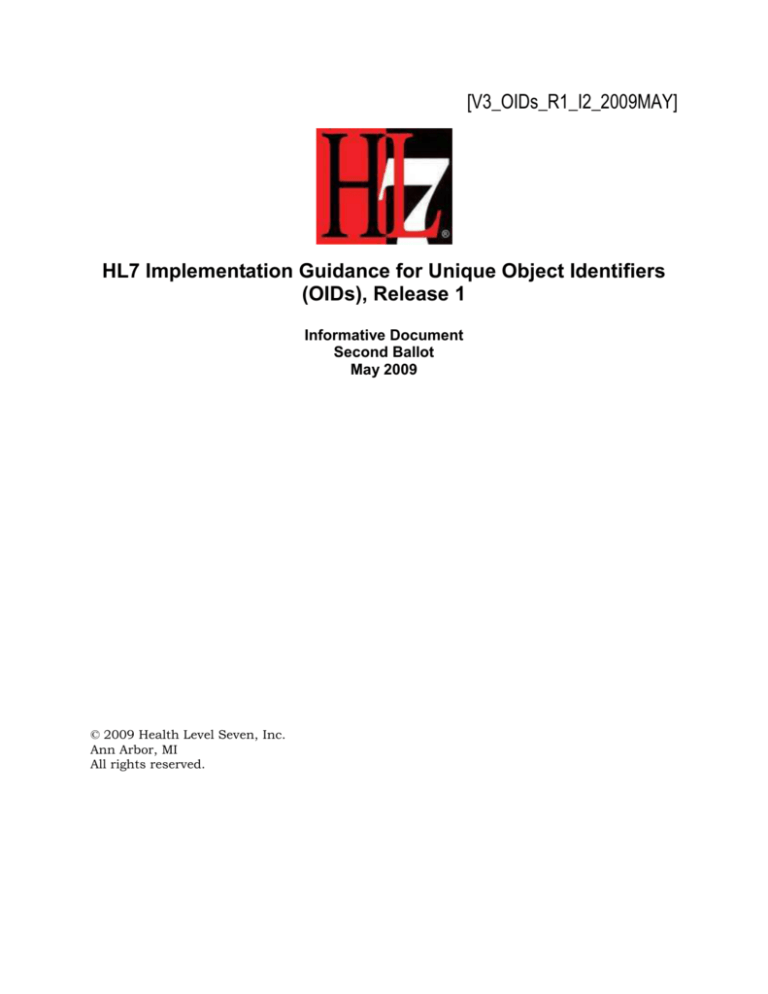
[V3_OIDs_R1_I2_2009MAY]
HL7 Implementation Guidance for Unique Object Identifiers
(OIDs), Release 1
Informative Document
Second Ballot
May 2009
© 2009 Health Level Seven, Inc.
Ann Arbor, MI
All rights reserved.
Co-Chair/Co-Editor:
Keith W. Boone
GE Healthcare
keith.boone@ge.com
Co-Chair:
Liora Alschuler
Alschuler Associates, LLC
liora@alschulerassociates.com
Co-Chair/Co-Editor:
Calvin Beebe
Mayo Clinic
cbeebe@mayo.edu
Co-Chair/Co-Editor:
Robert H. Dolin, MD
Kaiser Permanente
robert.h.dolin@kp.org
Co-Editor:
Ryan Murphy
Madigan Army Medical Center
ryan.w.murphy@us.army.mil
Co-Editor:
Rick Geimer
Alschuler Associates, LLC
rick@alschulerassociates.com
Co-Editor
Ted Klein
ted@tklein.com
Co-Editor
Drayton Rodrigues
Intermountain Healthcare
Drayton.Rodrigues@imail.org
Draft text
OID Usage [Universal Realm]
© 2009 Health Level Seven, Inc. All rights reserved.
1.0
Page 2
May 2009
Acknowledgments
The editors of this guide wish to thank all those who assisted in the creation and review
of this document. The largest debt of gratitude is owed to the participants in the
standards development process in HL7 who support this work through the development
of the foundation standards on which this Implementation Guide is based.
Draft text
OID Usage [Universal Realm]
© 2009 Health Level Seven, Inc. All rights reserved.
1.0
Page 3
May 2009
Table of Contents
1
2
INTRODUCTION .............................................................................................................. 6
1.1
Purpose ..................................................................................................................... 6
1.2
Audience ................................................................................................................... 6
1.3
Approach .................................................................................................................. 6
1.4
Contents of the Ballot Package ...................................... Error! Bookmark not defined.
1.5
Scope ........................................................................................................................ 7
1.6
Terms used in this Document .................................................................................... 7
OVERVIEW ..................................................................................................................... 8
2.1
What is an OID? ........................................................................................................ 9
2.2
Identifiers in CDA Documents and V3 messages....................................................... 11
2.2.1
Documents ....................................................................................................... 11
2.2.2
Patients ............................................................................................................ 12
2.2.3
Personnel ......................................................................................................... 13
2.2.4
Locations ......................................................................................................... 14
2.2.5
Organizations ................................................................................................... 14
2.2.6
Devices and Systems ........................................................................................ 14
2.2.7
Encounters ...................................................................................................... 15
2.2.8
Orders.............................................................................................................. 15
2.2.9
Sections ........................................................................................................... 16
2.2.10
Entries ............................................................................................................. 16
2.2.11
Templates ........................................................................................................ 16
2.2.12
Local Vocabularies ........................................................................................... 17
2.2.13
External References .......................................................................................... 17
2.3
Obtaining an OID .................................................................................................... 17
2.3.1
The HL7 OID Registry ............................................ Error! Bookmark not defined.
2.3.2
Constructing From a National Provider Identifier (NPI)Error! Bookmark not defined.
2.3.3
Other Standards Organizations .............................. Error! Bookmark not defined.
2.4
Suggestions for Partitioning an OID for Use in an Organization ................................ 18
2.4.1
Small to Medium Sized Organizations ............................................................... 18
2.4.2
Large Organizations .......................................................................................... 19
APPENDIX A —
DIFFERENCES IN IDENTIFIERS IN HL7 VERSION 2.X AND 3.................... 22
Introduction ..................................................................................................................... 22
HL7 Version 2.X Identifiers ............................................................................................... 22
Draft text
OID Usage [Universal Realm]
© 2009 Health Level Seven, Inc. All rights reserved.
1.0
Page 4
May 2009
HL7 Version 3.0 Identifiers................................................................................................ 23
Coded Concepts ................................................................................................................ 24
APPENDIX B —
COMMON OIDS ........................................................................................ 25
APPENDIX C — SAMPLE OIDS USING THE SUGGESTED HIERARCHY FOR LARGE
ORGANIZATIONS .......................................................................................................... 28
Table of Figures
Figure 1 Identifier Example .................................................................................................... 8
Figure 2 ClinicalDocument.id and ClinicalDocument.setId Example ..................................... 12
Figure 3 patientRole.id Example ........................................................................................... 12
Figure 4 patient.id Example using a Driver’s License number ............................................... 13
Figure 5 assignedAuthor.id Example using a national provider identifier ............................... 13
Figure 6 assignedEntity.id Example using a personnel identifer assigned by an instituion ..... 14
Figure 7 healthCareFacility..id Example ............................................................................... 14
Figure 8 providerOrganization.id Example using a locally assigned OID. ............................... 14
Figure 9 assignedAuthor.id example where the author is a device. ........................................ 15
Figure 10 encompassingEncounter.id Example ..................................................................... 15
Figure 11 order.id Example showing differnt OIDs used for the placer and filler order id for the
same order. .................................................................................................................. 16
Figure 12 Section.id Example ............................................................................................... 16
Figure 13 Act.id example ...................................................................................................... 16
Figure 14 ClinicalDocument.templateId example using a CCD and locally defined template ... 17
Figure 15 translation.codeSystem Example .......................................................................... 17
Figure 16: HL7 Version 2.X CK Data Type ............................................................................ 22
Figure 17: II Data Type as used in a CDA Document ............................................................. 23
Table of Tables
Table 1: Contents of the Ballot Package .................................................................................. 7
Table 2: Recommended OID Arcs for Small/Medium Size Organizations ................................ 19
Table 3: Parts of an Instance Identifier ................................................................................. 24
Table 4: Sample OID Hierarchy for a Large Organization ....................................................... 28
Draft text
OID Usage [Universal Realm]
© 2009 Health Level Seven, Inc. All rights reserved.
1.0
Page 5
May 2009
1 INTRODUCTION
The HL7 Clinical Document Architecture Release 2.0 (CDA R2) and HL7 Version 3
messaging specifications are standard formats for the communication of clinical
information between healthcare IT systems. These standards based on the HL7 Version
3 (V3) Reference Information Model (RIM) have been promoted for use in the exchange
of clinical information across the globe and are required in various national and
regional programs.
One of the challenges in using the CDA and V3 messages is in understanding how to
obtain and manage values used to label the different identifiers in the Clinical
Document or within the V3 message. These values are known as Object Identifiers
(OIDs), and are described in further detail in the overview section.
1.1 Purpose
The purpose of this document is to describe how to manage the various values needed
to provide global uniqueness for identifiers used for patients, documents, providers and
other entities when appearing in clinical documents. This guide may assist
organizations to develop an OID maintenance strategy where none already exists. It is
not intended to replace existing strategies already in use.
1.2 Audience
The audience for this document includes software developers, implementers, architects
and consultants responsible for implementation of Electronic Health Record (EHR)
systems, Electronic Medical Record (EMR) systems, Personal Health Record (PHR)
systems, dictation/transcription systems, document management applications, and
local, regional and national health information exchange networks that create or
process CDA documents or HL7 Version 3 Messages.
1.3 Approach
This document approaches the assignment of OIDs to a V3 document or message by
first describing how healthcare organizations can acquire an OID that they may use as
a root OID. Secondly it describes how that OID can then be used to generate new OIDs
which can be used to label the different identifiers used within clinical documents or
messages produced by that organization. Although this document primarily focuses on
examples drawn from CDA documents, the same approach would also apply to V3
messages.
Draft text
OID Usage [Universal Realm]
© 2009 Health Level Seven, Inc. All rights reserved.
1.0
Page 6
May 2009
1.4 Scope
This document is intended for use by small, medium, or large healthcare organizations
to provide guidelines for obtaining and using OIDs. It can be applied to any CDA
implementation and most, if not all, HL7 Version 3 Message implementations that use
the Data Types Release 1 specification.
This document is intended to help organizations develop processes to manage OIDs.
When organizational structures change, the processes used to manage these OIDs may
also need to change. This document does not describe a transition path between
different processes. Organizations should consider possible transition paths when
selecting a strategy for managing OIDs.
1.5 Terms used in this Document
OID
An ISO Object Identifier. A globally unique identifier created
using the rules established in the ISO 9834 series of
standards
Registration Authority
A managed entity that can assign OIDs to other entities or for
specific purposes.
Draft text
OID Usage [Universal Realm]
© 2009 Health Level Seven, Inc. All rights reserved.
1.0
Page 7
May 2009
2 OVERVIEW
2.1
CDA documents and V3 messages need a wide variety of identifiers to uniquely identify
patients, locations, providers, organizations, and other things. These are
communicated in an HL7 data type called an Instance Identifier, or II as it is commonly
known. An example of this is shown in XML below in Figure 1.
<id root='2.16.840.1.113883.19.3.933.2' extension='MRN0009'>
Figure 1 Identifier Example
This example shows an identifier with two parts. The part most commonly recognized
as the identifier (MRN0009) appears in the extension attribute. However, this
identifier could readily be used somewhere else to identify the medical record of a
different patient, so it needs something extra to make it completely unique. That
something extra appears in the root attribute of the identifier.
In the definition of the II data type, the root attribute is required to be present and the
extension is optional. That’s because the root attribute can be constructed in a way
that makes it a globally unique identifier, meaning that no separate component is
needed. In most cases though, both the root and the extension attributes will be
present. In these cases, the root attribute uniquely identifies a unique collection or
“namespace” of identifiers that this identifier belongs to.
There are two choices for how this namespace can be identified in the root attribute.
The preferred way is to use what is called an OID, or ISO Object Identifier, which is the
focus of this document. An alternative scheme allowed by HL7 but not further described
here uses what is known as the Universally Unique Identifier or UUID, which is also
known as a Globally Unique Identifier of GUID1. When the OID (see 2.2 What is an OID
below) or UUID defines the namespace, the extension is used to store the rest of the
identifier.
While the root attribute has limits on how it is represented, the extension attribute is
an arbitrary string. The extension attribute hold the locally unique portion of the
identifier. This art of the identifier is created by a variety of different external systems,
and there are few realistic limits that can be placed on this string.
Identifiers are compared by comparing the root and extension attributes. If one
identifier contains an extension attribute and the other does not, the identifiers are
not the same. If both the root and extension components are identical (or the root
attributes are identical and both are missing the extension attribute), then the
identifiers are the same, and identify the same object.
When the identifiers are different it does not necessarily imply that these are different
objects. A person can be identified by their driver’s license number, a passport number
or many other possible ways. But it’s the same person regardless of which identifier
1
To make things even more confusing, DICOM uses the acronym UID when describing ISO Unique Identifiers.
Draft text
OID Usage [Universal Realm]
© 2009 Health Level Seven, Inc. All rights reserved.
1.0
Page 8
May 2009
you use. This example shows the importance of coordinating which identifiers are used
when communicating between different facilities, organizations, regions or countries.
The same object can appear more than once in a document or message. These
representations should use the same identifier for each representation, but as stated
above, this is not an absolute requirement.
Given how HL7 messages and documents are structured, the objects may appear using
different typeCode or classCode attributes. The classCode or typeCode attributes in
a message or document indicates the RIM class of the object. HL7 standards often
constrain values used in a model to a particular set attributes and legal values. This is
one reason these values might differ. Because more specialized RIM classes are derived
from more general RIM classes, (e.g., the Observation class is derived from the Act
class), they may be represented in the message or document using the less specific
values, so long as they obey other constraints on identity (e.g., the attributes of the
object may not change).
2.2 What is an OID?
An OID is globally unique identifier whose value is created by a registration authority
according to the ISO 9834 series of standards. A registration authority is simply some
entity that has been awarded the authority to create OIDs. That authority is granted by
a preexisting registration authority. The original registration authorities are defined in
the ISO standards.
OIDs are used in HL7 documents and messages to add global uniqueness to identifiers
used within the document. OIDs are also used to identify the vocabulary terminology
systems used in documents and messages. The term OID is short for Object Identifier,
and is specified in clause 28 of the ISO/IEC 8824:1990(E) standard describing the ASN1 notation. The HL7 Abstract Data Types standard defines an OID data type2 as being
a globally unique string representing an ISO Object Identifier (OID). In practical use, an
OID is a unique identifier that has a few simple rules around they how they are created
and managed.
HL7 treats OIDs as opaque identifiers. The only meaningful comparison between two
OIDs is that of equivalence. If two OIDs match character for character, they are
equivalent. No other relationships should be inferred from any similarities, and no
internal structure of an OID should ever be relied upon within an application.
Note: OIDs created through application of this guide or any other routine procedure will
have an internal structure. This internal structure may tempt users of OIDs to
interpret the contents. Avoid the temptation. This structure is merely a consequence of
applying a regular mechanism for assigning new numbers.
OIDs are structured in the form of a tree. At each fork in the tree, the branches coming
from that fork are labeled with a non-negative integer. The number of branches that
can appear at each junction point except the first is unlimited, as is the size of the
number used to label any branch. The path through the tree can be “written out” by
2
The OID data type is separate from the II data type described in the previous section.
Draft text
OID Usage [Universal Realm]
© 2009 Health Level Seven, Inc. All rights reserved.
1.0
Page 9
May 2009
listing the numbers of the branch that were taken in order, separated by periods. Since
there is only one way to write out each label, and only one path to each position in the
tree, each OID has a unique string representation.
1.0
1.2
0
2
0.9
9
0.0.2
0.0.1
2
1
1
0
16
1
0
2.1
2.16
2
Figure 2 The Tree Structure of OIDs
The path to any position in the tree can easily be recorded as the sequence of branches
traversed, in the order followed from the “trunk” of the tree. Each number is separated
by a period symbol. This produces the dotted decimal representation as you see in the
example of Figure 1 above3, and looks like an IP address on steroids. In the diagram
above, the path to the left-most branch would be 0.0.1 and 2.16 would represent the
path the right-most branch. Each decimal number in the string represents a single
branch of the tree. These branches can be owned by a registration authority; usually
interpreted in HL7 parlance as an "Assigning Authority." Two OIDs are identical if the
strings produced by traversing the branches are identical.
There are some additional details. The ISO standard places some restrictions on the
numbers that may be used for the branches at the first fork and who owns them.
Symbolic names are also associated with each branch of the tree, but since they aren’t
used in HL7 communications, they are not discussed in this document.
In order to minimize the potential for misinterpreting what the identifiers mean, a
combination of a good OID strategy and an implementation guide facilitates the sharing
of information.
While the ISO/IEC specification does not place limits on the length of an OID, or the
size of the numbers used in it, there are a few practical limitations. The first of these is
the length of the string representing the OID. Billions of healthcare objects in imaging
3
The particular OID we have used in this example is assigned by HL7 for the purpose of generating examples such
as you see here. It should not be used for any other purpose.
Draft text
OID Usage [Universal Realm]
© 2009 Health Level Seven, Inc. All rights reserved.
1.0
Page 10
May 2009
already use OIDs for identification via the DICOM standard. The DICOM standard
requires that OIDs be limited to no more than 64 characters. For most organizations,
this is a reasonable limit.
Organizations that have a long root OID may need to be careful implementing the
suggested OID partitioning schemes of this document. It is be possible using this
scheme to create OIDs that approach or exceed 64 characters in length. Such
organizations will need to decide if they want to continue to limit their OIDs to 64
characters by using a different partitioning scheme, obtaining a new root OID of lesser
length, or simply ignoring the 64 character length suggestion (understanding that such
OIDs may not be usable in some standards such as DICOM).
The second practical limit is on the internal OID representation. Although the digit
sequences between the decimal points are unbounded by the standard, some
implementations of the OID data type use integers (incorrectly) to represent each
branch. This imposes a practical limit of 231-1 (slightly over 2 billion) for a branch
label.
We recommend that managers of OIDs adhere to these limits when constructing OIDs,
and that the applications they manage that use OIDs not be reliant upon either of these
limits.
2.3 Identifiers in CDA Documents and V3 messages
The various kinds of identifiers appearing in CDA documents and V3 messages are
described in more detail below. Please note that this is a guidance paper. Any specific
use of OIDs should be described in an implementation guide.
2.3.1 Documents
The first identifier encountered in a CDA document is the first <id> element in the
document. This is the one that explicitly identifies that document. There is only one of
these identifiers in the document, and it uniquely identifies the specific document that
contains it. No two CDA documents in the world have the same document ID. If there
are two different versions of a document, each one has a different document ID.
Healthcare IT systems typically maintain a unique identifier for a collection of document
versions. This may be stored in the <setId> element in the document.
The example below shows the use of these two different identifiers in the header of a
clinical document.
Draft text
OID Usage [Universal Realm]
© 2009 Health Level Seven, Inc. All rights reserved.
1.0
Page 11
May 2009
<ClinicalDocument xmlns="urn:hl7-org:v3">
<realmCode code="US"/>
<typeId extension="POCD_HD000040" root="2.16.840.1.113883.1.3"/>
<templateId root="2.16.840.1.113883.10.20.1"/>
<id root="2.16.840.1.113883.19.3.933.1.999021.1"/>
<code code="34133-9" displayName="SUMMARIZATION OF EPISODE NOTE"
codeSystem="2.16.840.1.113883.6.1" codeSystemName="LOINC"/>
<title>Good Health Clinic Care Record Summary</title>
<effectiveTime value="20050303171504+0500"/>
<confidentialityCode code="N" codeSystem="2.16.840.1.113883.5.25"/>
<languageCode code="en-US"/>
<setId extension="999021" root="2.16.840.1.113883.19.3.933.1"/>
<versionNumber value="1"/>
Figure 3 ClinicalDocument.id and ClinicalDocument.setId Example
The example above shows the document identifier using single OID with no extension
attribute. This is permitted in the II data type by the HL7 standards. This facilitates
exchange between standards such as DICOM that only use an OID to identify objects,
and the HL7 CDA Standard. This is required behavior when it is necessary to support
exchanges of persistent objects between a system using the DICOM standard and a
system using HL7 Version 3 standards. Note that in these cases, the OID would be
limited to 64 characters in length.
2.3.2 Patients
Several types of patient identifiers will likely need to be managed. An organization may
use multiple identifiers for patients, for example, account identifiers, medical record
numbers, and master patient identifiers. Each of these different types of identifier
should have a separate OID.
Most common types of identifiers (such as U.S. Social Security Numbers) have already
had their namespaces associated with an assigned OID and registered through the HL7
OID registry. Organizations should typically only need to assign OIDs for the
namespaces for internally assigned identifiers.
First, organizationally assigned patient ids should have their own unique root OID that
scopes them. Each type of id should have a separate OID (i.e. single system id vs.
another system id vs. a master patient index id). These identifiers are found in the
<id> element under the <patientRole> element of the document, and identify the person
in their role as a patient, as shown below.
<patientRole>
<id extension="12345" root="2.16.840.1.113883.19.3.933.2"/>
Figure 4 patientRole.id Example
In addition to organizationally assigned ids, it is likely that external ids for a person will
also appear in CDA documents (i.e. Health Plan Identifier, driver's license numbers,
etc.). For ids that already have OIDs, the existing ones should be utilized for
interoperability. Otherwise an organizational OID should be created for each namespace
to scope each type of id. Lastly, it should be noted that each patient will likely have
Draft text
OID Usage [Universal Realm]
© 2009 Health Level Seven, Inc. All rights reserved.
1.0
Page 12
May 2009
multiple ids associated with them, so any OID management solution needs to take this
into account.
These identifiers are often found in the <id> element of the <patient>, as they identify
the person in the role, and not the role, as shown in the example below.
<patient>
<id root="2.16.840.1.113883.4.3.24" extension="0000000"/>
Figure 5 patient.id Example using a Driver’s License number
2.3.3 Personnel
Personnel includes licensed providers, non-licensed medical staff, clerical and other
staff that may need access to, or who contribute to the development of the content in
the document or message. These individuals may need to be identified within a clinical
document (e.g. the transcriptionist may be recorded as the dataEnterer in a CDA
document).
There are laws that mandate the use of certain identifiers for various classes of
providers for various purposes, e.g., to prescribe restricted medications, or to identify a
provider for the purpose of payment. HL7 has already assigned OIDs for many of these
organizational namespaces, and these are preferred over other OIDs that may refer to
the same namespace. Appendix B —Common OIDs lists a number of these, and
includes a link to the HL7 OID Registry where OIDs that have already been registered
can be located. The example below shows an author being identified using the US
national identifier for healthcare providers.
<author>
<time value="20050329224411+0500"/>
<assignedAuthor>
<id extension="999999999" root="2.16.840.1.113883.4.6"/>
Figure 6 assignedAuthor.id Example using a national provider identifier
In other cases where the organization (instead of some other authority) assigns an
identifier to non-patient personnel, the issues surrounding OID management for those
persons (authors, authenticators, informants, healthcare providers, and other
document participants) are largely the same as for patients. The example below shows
a locally assigned identifier used for a transcriptionist entering a report.
Draft text
OID Usage [Universal Realm]
© 2009 Health Level Seven, Inc. All rights reserved.
1.0
Page 13
May 2009
<dataEnterer>
<time value="20050329222451+0500"/>
<assignedEntity>
<id extension="2" root="2.16.840.1.113883.19.3.933.3"/>
Figure 7 assignedEntity.id Example using a personnel identifer assigned by an instituion
2.3.4 Locations
If facilities or locations will be listed in CDA documents, then each facility should have a
unique id. Each facility can be assigned its own unique OID, or an organization can
create an OID for facility ids and assign unique extensions for each facility. The
example below shows the latter usage.
<location typeCode="LOC">
<healthCareFacility>
<id extension="R123" root="2.16.840.1.113883.19.3.933.4"/>
…
Figure 8 healthCareFacility.id Example
2.3.5 Organizations
There are laws mandating the use of certain identifiers for organizations, such as CLIA
(Clinical Laboratory Improvement Amendments) laboratories in the U.S. reporting to
state cancer registries. HL7 has already assigned OIDs for many of these organizational
namespaces, and these should be used where possible. Some organizations recorded in
a document or message may need to be assigned a local identifier where an external
identifier does not already exist. In these cases, the local identifiers should have a
unique OID that serves to identify that namespace of local identifiers for these
organizations. The example below shows a provider organization being identified using a
locally assigned identifier.
<providerOrganization>
<id extension="M345" root="2.16.840.1.113883.19.3.933.5"/>
Figure 9 providerOrganization.id Example using a locally assigned OID.
2.3.6 Devices and Systems
It will likely be very useful to assign OIDs to information systems that span multiple
locations. These OIDs will be usable directly when they are listed as authors of a CDA
document (/ClinicalDocument/author/assignedAuthor/id). The example below shows
an identifier being used for a device authoring a report.
Draft text
OID Usage [Universal Realm]
© 2009 Health Level Seven, Inc. All rights reserved.
1.0
Page 14
May 2009
<assignedAuthor>
<id extension="1" root="2.16.840.1.113883.19.3.933.6"/>
Figure 10 assignedAuthor.id example where the author is a device.
It may also be useful to assign OIDs to these information systems, and then create OID
branches off that system OID for each of the other categories mentioned in this
document.
2.3.7 Encounters
OIDs should be created to scope (or identify the namespace of) any identifiers found in
encounters (assuming appropriate OIDs do not already exist). Identifiers for
encounters can include visit identifiers or appointment identifiers. The example below
shows an identifier for an encounter. The organization that creates the identifier should
be the one providing the OID associated with it.
<encompassingEncounter>
<id extension="9937012" root="2.16.840.1.113883.19.3.933.7"/>
Figure 11 encompassingEncounter.id Example
2.3.8 Orders
OIDs should be created to scope the different kinds of identifiers generated by an
application for orders. Some applications generate a placer order number (identifying
an order), others generate a filler order number (identifying a promise to fulfill the
order), and yet others generate both. When receiving an order, order fillers should use
the identifier (and OID) supplied by the order placer. When receiving a promise, order
placers should use the identifier (and OID) supplied by the order filler.
In some cases the order placer or order filler may not supply an OID to identify a
namespace. For example, the information sent in an HL7 V2 message may include
identifiers that are only locally unique in the context of the message. In this situation,
the receiver needs to be aware that there may be legal and patient safety issues around
assigning OIDs for these identifiers since the receiver cannot guarantee the uniqueness
of the resulting identifier. HL7 has supported identification of assigning authorities5 for
identifiers since version 2.3. It is HL7's position that the responsibility for providing
these assigning authorities resides with the originators of the identifiers, not the
receivers of the identifiers.
The example below shows the use of both the placer and filler order number to identify
an order, with different OIDs used for each identifier.
5
The HD data type replaced the used of strings for identifying the assigning authority in HL7 Version 2.3. The first
two examples on page 2-34 of the HL7 Version 2.3.1 standard illustrate how an ISO OID is represented in the HD
data type.
Draft text
OID Usage [Universal Realm]
© 2009 Health Level Seven, Inc. All rights reserved.
1.0
Page 15
May 2009
<inFulfillmentOf typeCode="FLFS">
<order moodCode="RQO">
<id extension="placer1" root="2.16.840.1.113883.19.3.933.8.1"/>
<id extension="filler2" root="2.16.840.1.113883.19.3.933.8.2"/>
Figure 12 order.id Example showing different OIDs used for the placer and filler order id for the
same order.
2.3.9 Sections
Sections within a CDA document may be identified. An OID should be generated to
identify the namespace of CDA sections. The example below shows an identifier used
for a section of a clinical document.
<section>
<id root='2.16.840.1.113883.19.3.933.1.999021.1.9' extension='1'/>
Figure 13 Section.id Example
2.3.10 Entries
Entries within a CDA document may also be identified. The example below shows an
identifier for an Act appearing in an entry of a clinical document. Note: The identifiers
for these entries should be traceable back to the data in the health information system
or clinical data repository used to produce them.
<entry>
<act classCode='ACT' moodCode='EVN'>
<id root='2.16.840.1.113883.19.3.933.1.999021.1.10' extension='1'/>
Figure 14 Act.id example
2.3.11 Templates
Templates can also be identified. We recommend that each template have its own
unique OID and not use an extension. The example below shows a clinical document
using two templates, one defined by the HL7 Continuity of Care Document specification
and the other locally defined.
Draft text
OID Usage [Universal Realm]
© 2009 Health Level Seven, Inc. All rights reserved.
1.0
Page 16
May 2009
<ClinicalDocument xmlns="urn:hl7-org:v3" >
<typeId root="2.16.840.1.113883.1.3" extension="POCD_HD000040"/>
<templateId root="2.16.840.1.113883.10.20.1"/>
<templateId root="2.16.840.1.113883.19.3.933.11"/>
Figure 15 ClinicalDocument.templateId example using a CCD and locally defined template
2.3.12 Local Vocabularies
OIDs are also used to uniquely identify vocabularies or coding systems in elements
using the HL7 CD data type or its subtypes. These OIDs appear in the codeSystem
attribute of the element, as shown in the figure below.
<code … >
<translation code="CCD" codeSystem="2.16.840.1.113883.19.3.933.12.1"/>
</code>
Figure 16 translation.codeSystem Example
Whenever possible, existing code systems such as LOINC or SNOMED CT should be
used. If it is necessary to use organizational specific vocabularies, then OIDs should be
created to scope the local codes. The assigning organization should ensure that an
existing global or local OID is not already available for the purpose before creating a
new OID. Strategies should be established to avoid assignment of multiple OIDs for the
same code systems.
The example above shows where an OID is used in a translation element for the local
code system that is used to represent the type of a clinical document.
2.3.13 External References
A CDA document may reference external objects that use OIDs for identification. An
example would be a reference to a DICOM image (DICOM commonly uses OIDs to
identify objects).
2.4 Obtaining an OID
There are two reasons to obtain an OID. The first is to be able to use that OID as a
namespace identifier for identifiers that you manage. This can be accomplished by
asking a registration authority, such as HL7 for an OID to use for that purpose.
The second reason is to become a registration authority. Once you have a registration
authority OID of your own, you become a registration authority and can create other
OIDs and use them yourself or give them to others. A registration authority may
delegate the registration authority for OIDs below it to another entity, which can then
assign other OIDs beneath the assigned value, as specified in the ISO 8824 series of
standards governing policies and procedures for registration authorities.
Draft text
OID Usage [Universal Realm]
© 2009 Health Level Seven, Inc. All rights reserved.
1.0
Page 17
May 2009
Organizations that do not already have a registration authority OID may obtain one
from a number of different sources. These are described in further detail below. There
is no requirement that an organization obtain the OIDs used in their documents and
messages from any particular source. However obtained, an OID owned by an
organization should be registered with the HL7 registry to enable others to identify your
organization as the owner. See the section on Error! Reference source not found.
below.
Note that an OID can never be changed to identify a different object once it has been
assigned, even by the Registration Authority. In other words, OIDs must never be
recycled. Rather, new OIDs should be created when and the old ones retired from use.
OIDs for registration authorities or namespaces can be obtained from HL7 by using the
HL7 OID Registry found on the web at http://www.hl7.org/oid/. Under “RESOURCES”
click on “OID Registry”. On the upper right corner of the OID Registry page, click on
“Click to obtain or register an OID”. When you ‘obtain’ a new OID from HL7, it is
automatically registered for you rather than requiring an additional step.
Various HL7 international affiliates also maintain OID registries. Please check with your
local affiliate home page for more information.
2.5 Suggestions for Partitioning an OID for Use in an Organization
The following guidelines are for use by organizations that are new to OIDs and are
looking for some guidance on OID implementation and management. This guide does
not suggest that organizations that already have OIDs and have been managing them
for some time should change to using the approaches outlined below.
The guidelines below are intended to enable organizations to manage the OIDs that they
use. These are not intended to communicate organizational structures. Receiving
systems should not assume that OIDs received from any particular organization will
match the recommendations outlined in this guide, or that when they do that any given
organizational structure is assumed. Many existing systems use OIDs in forms such as
Manufacturer.serial-number.time or Manufacturer.serial-number.time-hash.
Implementations receiving OIDs must be able to accept any and all possible OID
generation methods, and never depend on the OID tree having any structure
whatsoever.
The partitioning scheme described below uses the rubric that objects of the same type
(in the RIM) appear in the same namespace (use the same OID). You could manage a
namespace so that it could include for example, identifiers for both patients and
documents, but this presents a number of challenges and is not recommended.
2.5.1 Small to Medium Sized Organizations
There are several assumptions made in this section with regard to the way that OIDs
are managed. If these assumptions do not apply in your situation, you should look to
the OID partitioning scheme defined in section 2.5.2, Large Organizations.
The organization uses the same identifier to uniquely identify a patient across
different encounters and locations. This can either be the medical record
Draft text
OID Usage [Universal Realm]
© 2009 Health Level Seven, Inc. All rights reserved.
1.0
Page 18
May 2009
number, or master patient identifier used by the organization to identify a
patient.
The organization makes use of a single electronic medical record system (EMR)
across its various locations of care.
The organization uses the same identifier to uniquely identify personnel
regardless of location.
There are a manageable number of locations, and a way to uniquely identify each
of these locations within the scope of the organization.
There are a manageable number of entities that the organization places orders
with, and a way to uniquely identify each of these entities within the scope of the
organization.
Once an organization receives a root OID of their own, it is recommended that they
create new OIDs using the values in the table below. Please note that in some locales,
national identifiers may be in use for patients, personnel or organizations. Nationally
managed identifiers should be assigned an OID of their own, and that should be
registered within the HL7 OID Registry. Where these nationally assigned identifiers are
used, a locally managed OID should not be assigned.
Table 1: Recommended OID Arcs for Small/Medium Size Organizations
Branch
Description
.1
Documents
.2
Patients
.3
Personnel
.4
Locations
.5
Organizations
.6
Devices
.7
Encounters
.8
Orders
.9
Sections
.10
Entries and Clinical Statements
.11
Templates
.12
Local Vocabularies
.13
Other Participants
For example: if an organization had a root OID of 2.16.840.1.113883.19.3.933.19.4,
then the OID for documents would be 2.16.840.1.113883.19.3.933.19.4.1, and patients
would be 2.16.840.1.113883.19.3.933.19.4.2, etc.
2.5.2 Large Organizations
The recommended solution for managing OIDs for large organizations or organizations
with the potential to expand is to start with the organization's OID and have a three
node hierarchy for each particular OID.
Draft text
OID Usage [Universal Realm]
© 2009 Health Level Seven, Inc. All rights reserved.
1.0
Page 19
May 2009
The organizational OID would typically be the root. The first level is the assigned
system ID. The second level is the site specific ID, and the third level is the OID
category (1 for document ids, 2 for patient ids, 3 for provider ids, etc.). The OID
categories should be predefined as much as possible, but if the local site needed an OID
category that was not predefined, they would have the flexibility to define their own OID
category. If possible, that new OID category should be added to this document so other
sites can use the same OID category if needed.
In some instances, it may be necessary to have additional levels of ownership to manage
OIDs within an organization. That may affect the OID structure described below but it
may also be incorporated into the structure depending on your internal management
strategy. Additional levels of structure can be incorporated to track, for example, the
version of the organizations OID management scheme used to create the OID.
Assigning OIDs along organizational boundaries is a convenience mechanism for
managing them. The OIDs are not meant to communicate organizational structures.
Organizational structures are not necessarily stable, departments can be split, or
merged or added or removed over time, especially in large organizations where this
occurs frequently.
In order to completely explain how the recommended solution should work, here are a
few fake pieces of information that will be used to create the organizational OIDs.
Good Health Clinic has an organizational OID of 2.16.840.1.113883.3.933.999
and has multiple facilities in several locations.
Each facility uses the same computer systems which they have identified as
system 120 (outpatient care), 150 (inpatient care) and 170 (emergency care).
Each of those systems operates independently.
There is one central master patient index (MPI) that helps tie all of the records
together. The MPI has been identified as system 2000 and is located at the
main clinic which is clinic 1.
Each of the clinics has been incrementally assigned an ID in the order that the
clinic was opened. The first clinic has an ID of 001. The second clinic is 002,
etc. When using these in an OID, the leading zero's need to be removed.
Based on the information above, here are a few examples of how the OIDs would be
created:
2.16.840.1.113883.19.3.933.999
o
Good Health organizational OID
2.16.840.1.113883.19.3.933.999.120
o
120 is the outpatient system.
o
This is the first branch and the OID is not yet complete.
2.16.840.1.113883.19.3.933.999.120.1
o
The outpatient system (120) used at clinic 001 (1).
o
This is the second branch and the OID is not yet complete.
Draft text
OID Usage [Universal Realm]
© 2009 Health Level Seven, Inc. All rights reserved.
1.0
Page 20
May 2009
2.16.840.1.113883.19.3.933.999.120.1.1
o
A document ID (1) on that system.
o
This is the third and final branch- the complete OID
More examples of complete OIDs:
2.16.840.1.113883.19.3.933.999.120.1.2
o
Description: outpatient system (120), used at clinic 001 (1), with a
patient ID (2)
2.16.840.1.113883.19.3.933.999.120.5.2
o
Description: outpatient system (120), used at clinic 005 (5), with a
patient ID (2)
2.16.840.1.113883.19.3.933.999.150.5.2
o
Description: inpatient system (150), used at clinic 005 (5), with a
patient ID (2)
2.16.840.1.113883.19.3.933.999.2000.1.2
o
Description: MPI system (2000), used at clinic 001 (1), with a patient ID
(2)
Wherever possible, large organizations whose OIDs appear in documents and messages
exchanged with external parties should register their OIDs with the HL7 OID registry so
that they can be easily identified by those external parties.
Draft text
OID Usage [Universal Realm]
© 2009 Health Level Seven, Inc. All rights reserved.
1.0
Page 21
May 2009
DIFFERENCES IN IDENTI FIERS IN HL7
VERSION 2.X AND 3
Introduction
The CDA makes use of HL7 Version 3.0 Reference Information Model, Data Types, and
Vocabulary. The structure of identifiers has changed between HL7 Version 2.X and
HL7 Version 3.
An advancement in the HL7 Version 3.0 data types over HL7 Version 2.X is a
refinement in the way identifiers are communicated in documents and messages.
HL7 Version 2.X Identifiers
In HL7 Version 2.X, identifiers were sent using one of several data types, including the
CK, CX, or EI data types, or along with names in the CN, PPN, XCN and XON data
types. In each case, the identifier had at least two parts, the identifier itself, which is a
string, and a field identifying the Assigning Authority for that identifier. An example is
shown below for the HL7 Version 2.X CK data type.
<ID number (NM)> ^ <check digit (NM)> ^
<code identifying the check digit scheme employed (ID)> ^ < assigning
authority (HD)>
Figure 17: HL7 Version 2.X CK Data Type
In HL7 Version 2.3 and beyond, the Assigning Authority is stored in an "HD" data type.
Many other parts of V2.X messages also use the HD data type, especially in the
message header. The HD data type is described as follows:
HL7 Component Table - HD – Hierarchic Designator
SEQ
LEN
DT
OPT
1
2
3
20
199
6
IS
ST
ID
O
C
C
COMPONENT NAME
Namespace ID
Universal ID
Universal ID Type
Definition: The basic definition of the HD is that it identifies an
(administrative or system or application or other) entity that has
responsibility for managing or assigning a defined set of instance identifiers
(such as placer or filler number, patient identifiers, provider identifiers,
etc.). This entity could be a particular health care application such as a
registration system that assigns patient identifiers, a governmental entity
such as a licensing authority that assigns professional identifiers or drivers’
license numbers, or a facility where such identifiers are assigned.
The HD data type allows the assigning authority to be identified with a string, and/or
any one of the following:
a DNS name,
a UUID (also known as GUID),
a CEN Healthcare Coding Scheme Designator,
Draft text
OID Usage [Universal Realm]
© 2009 Health Level Seven, Inc. All rights reserved.
1.0
Page 22
May 2009
an ISO Unique Object Identifiers (also known as an OID),
a random string of bits,
an X.400 format identifier
or an X.500 directory name.
There were several problems with the use of this data type to identify the assigning
authority. The assigning authority could be identified in either or both of two different
ways in the message, using a simple text string, and a specially formatted value. There
were also numerous ways to generate an Assigning Authority identifier using the
specially formatted string that did not always guarantee uniqueness.
HL7 Version 3.0 Identifiers
HL7 Version 3.0 uses the II data type to record identifiers. As in HL7 Version 2.X, the
data type used for identifiers allows for the storage of both the identifier, and a value
guaranteeing the uniqueness of the identifier.
<id extension="999021" root="2.16.840.1.113883.19.3.933.1.999021.1"
assigningAuthorityName='HL7' displayable='true'/>
Figure 18: II Data Type as used in a CDA Document
The value that guarantees the uniqueness is known as a universal identifier, and is
defined as the HL7 Version 3 data type UID. A universal identifier is one which is
generated in a way that guarantees that no other identifier will duplicate it. Two
examples of universal identifiers are UUIDs (or GUIDs), and OIDs. Both of these
formats specify a process for generating identifiers that will, if correctly followed,
generate identifiers that will not be duplicated by any other system.
Another refinement was the recognition that a universal identifier could be used as an
identifier for an entity that did not require the specification of any other information.
To accommodate these changes, the parts of an identifier in HL7 Version 3.0 include
two main attributes, the root and the extension. The definitions of these parts are given
in the table below.
Draft text
OID Usage [Universal Realm]
© 2009 Health Level Seven, Inc. All rights reserved.
1.0
Page 23
May 2009
Table 2: Parts of an Instance Identifier
Name
Type
Description
root
UID
A unique identifier that guarantees the global uniqueness
of the instance identifier. The root alone may be the entire
instance identifier.
extension
ST
A character string as a unique identifier within the scope
of the identifier root.
assigningAuthorityName
ST
A human readable name or mnemonic for the assigning
authority. The Assigning Authority Name has no
computational value. The purpose of a Assigning Authority
Name is to assist an unaided human interpreter of an II
value to interpret the authority. Note: no automated
processing must depend on the assigning authority name
to be present in any form.
displayable
BL
Specifies whether the identifier is intended for human
display and data entry (displayable = true) as opposed to
pure machine interoperation (displayable = false).
In an HL7 Version 3.0 identifier, the root attribute often takes the place of the assigning
authority identifier used in HL7 Version 2.X, and the extension often takes the place of
the identifier string. The one exception to these cases is when the identifier itself is
guaranteed to be unique and is either an OID or GUID, in which case an extension
attribute is not required, and the root attribute contains the entire identifier.
Coded Concepts
The HL7 Version 3 CD data type (also called the Concept Descriptor data type) uses
OIDs to identify coding systems. The CD data type can be thought of as an identifier for
a specific concept. The table below describes the two attributes of the CD data type
associated with OIDs.
Name
Type
Description
codeSystem
OID
A unique identifier that uniquely identifies the code
system. This attribute is like the root attribute of the II
data type described above.
codeSystemName
ST
A human readable name or mnemonic for the code
System. The Code System Name has no computational
value. The purpose of a Code System Name is to assist an
unaided human interpreter of an CD value to interpret the
code system. Note: no automated processing must depend
on the code system name to be present in any form. This
attribute is like the assigningAuthorityName attribute of
the II data type described above.
Draft text
OID Usage [Universal Realm]
© 2009 Health Level Seven, Inc. All rights reserved.
1.0
Page 24
May 2009
COMMON OIDS
Below are a few example OIDs that are already defined and should be used when
possible rather than defining additional OIDs that describe the same ID. For a
complete list, visit the following site: www.hl7.org/oid
OID
Name
Notes
2.16.840.1.113883.4.1
United States Social Security
Number (SSN).
Assigned by the U.S. Social
Security Administration. Note:
IRS assigned ITINs are often
used as drop-ins for social
security numbers.
2.16.840.1.113883.4.330.392
passportNumNS-JPN
Identifier of the namespace for
Passport Numbers issued by
the country of JAPAN. Used
for II.root values for passport
numbers.
2.16.840.1.113883.4.330.36
passportNumNS-AUS
Passport Numbers issued by
the country of Australia
2.16.840.1.113883.3.42
DOD_MHS
This is the root OID for the
U.S. Military Health System
(MHS).
It uses the OID hierarchy
described in this document for
large organizations.
2.16.840.1.113883.4.6
NPI
U.S. National Provider
Identifier
2.16.840.1.113883.4.58
Yukon, Canada Personal
Health Number
A unique number assigned by
the Yukon territory, Canada to
patients
or clients who come into
contact with their
jurisdictional healthcare
system.
2.16.840.1.113883.4.322
PPID
Alberta, Canada Provincial
Provider Identifier (PPID)
OIDs are also used to identify coding systems. These OIDs are used in the HL7 Version 3 CD
data type. The table below provides the OIDs for a number of common coding systems.
Draft text
OID Usage [Universal Realm]
© 2009 Health Level Seven, Inc. All rights reserved.
1.0
Page 25
May 2009
OID
Code System Name
Notes
2.16.840.1.113883.6.96
SNOMED-CT
Systematized Nomenclature in
Medicine Clinical Terms
2.16.840.1.113883.6.103
ICD-9-CM Diagnoses
Diagnosis codes from the US
ICD-9-CM Coding system.
2.16.840.1.113883.6.1
LOINC
Logical Observation Identifiers
Names and Codes
Draft text
OID Usage [Universal Realm]
© 2009 Health Level Seven, Inc. All rights reserved.
1.0
Page 26
May 2009
2.16.840.1.113883.6.12
CPT-4
Common Procedure
Terminology
2.16.840.1.113883.6.104
ICD-9-CM Procedures
Procedure codes from the US
ICD-9-CM Coding system.
2.16.840.1.113883.6.88
RxNORM
Drug codes from the US
National Library of Medicine
RxNORM Code System
2.16.840.1.113883.6.69
NDC
US National Drug Codes
Draft text
OID Usage [Universal Realm]
© 2009 Health Level Seven, Inc. All rights reserved.
1.0
Page 27
May 2009
S AM PLE OIDS USING TH E SUGGESTED
HIERARCHY FOR LARGE ORG ANIZATIONS
The following pages contain a sample OID hierarchy. This material was derived from the
structure created for the U.S. Military Health System (MHS). This structure uses the
recommended solution for large organizations described in this document.
Table 3: Sample OID Hierarchy for a Large Organization
Full OID
Type of OID
2.16.840.1.113883.19.3.42
Organization RA OID: Military Health System
2.16.840.1.113883.19.3.42.126
2.16.840.1.113883.19.3.42.126.100001
System RA OID: the AHLTA System
Facility RA OID: Global IDs in AHLTA
2.16.840.1.113883.19.3.42.126.100001.2
Namespace OID: Patients
2.16.840.1.113883.19.3.42.126.100001.16
Namespace OID: Concepts
2.16.840.1.113883.19.3.42.126.100001.19
Namespace OID: Events
2.16.840.1.113883.19.3.42.127
2.16.840.1.113883.19.3.42.127.5
System RA OID: CHCS
Facility RA OID: Basset Army Community Hosp.
2.16.840.1.113883.19.3.42.127.5.2
Namespace OID: Patients
2.16.840.1.113883.19.3.42.127.5.3
Namespace OID: Providers
2.16.840.1.113883.19.3.42.127.110
Facility RA OID: Darnall Army Medical Center
2.16.840.1.113883.19.3.42.127.110.2
Namespace OID: Patients
2.16.840.1.113883.19.3.42.127.110.3
Namespace OID: Providers
2.16.840.1.113883.19.3.42.127.1667
Facility RA OID: Groton Naval Medical Center
2.16.840.1.113883.19.3.42.127.1667.2
Namespace OID: Patients
2.16.840.1.113883.19.3.42.127.1667.3
Namespace OID: Providers
2.16.840.1.113883.19.3.42.144
2.16.840.1.113883.19.3.42.144.125
System RA OID: CIS
Facility RA OID: Madigan Army Medical Center
2.16.840.1.113883.19.3.42.144.125.1
Namespace OID: Documents
2.16.840.1.113883.19.3.42.144.125.4
Namespace OID: Encounters/Visits
2.16.840.1.113883.19.3.42.144.100001
2.16.840.1.113883.19.3.42.144.100001.17
2.16.840.1.113883.19.3.42.10005
2.16.840.1.113883.19.3.42.10005.10001
2.16.840.1.113883.19.3.42.10005.100001.1
2.16.840.1.113883.19.3.42.10005.100001.18
Facility RA OID: Global IDs in CIS
Namespace OID: Account Numbers
System RA OID: Document Management System
Facility RA OID: Global IDs for Document Management
Namespace OID: Document IDs
Namespace OID: Document Set IDs
Draft text
OID Usage [Universal Realm]
© 2009 Health Level Seven, Inc. All rights reserved.
1.0
Page 28
May 2009

